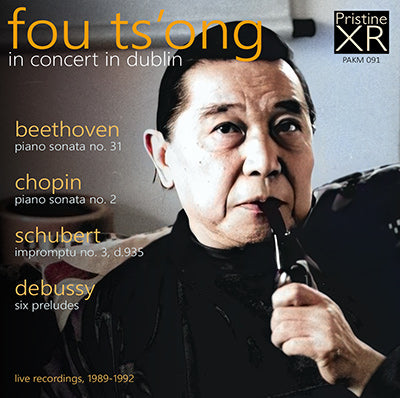
This album is included in the following sets:
This set contains the following albums:
- Producer's Note
- Full Track Listing
- Cover Art
“In the first Impromptu of Schubert’s second set, Fou suggested the ongoing figure of a symphonic movement and the tonal richness of an orchestra. The variations of the third Impromptu had an exceptional sense of momentum, too, with liquid pianissimo in the second variation yet no undue straining after incidental felicities … He chose the last six Preludes of Debussy’s second book, which gave him the opportunity to revel in cat-like athleticism and gestural caprice. He had already shown the discreet warmth of his pedalling and control of nuance in Mozart, but here, at the end of ‘Canope’, there was the most delicate and exact diminuendo possible and, at the other extreme, a scintillating sequence of shocks in ‘Feux d’artifice’.”
– Adrian Jack, The Independent, 12 June 1991
“What Paderewski said to Malcuzyuski is the advice of a great master: you must listen to yourself. It's not easy, it takes time, and for me, the learning never stops. I have to learn a particular sound and try to produce it in a thousand different ways. Of course, it's useful to follow a routine, to play without the pedals or to play in strict time, slowing down the piece and learning it in chords, so as to grasp it harmonically. With Debussy, Beethoven, Schubert, Chopin, all the great composers, everything written on the page is important. What else do we have? If you ignore notation, you produce a non-effect that is completely detached from the composer's intention. Music can be played in many different ways, as long as it is played convincingly. But nothing is convincing, nothing is correct unless it is grammatical, and nothing is grammatical unless the language of the score is reproduced. We must at least try to follow this path.”
– Fou Ts’ong, Piano Le Magazine, January 2000
The life story of Fou Ts’ong, born in 1934 in Shanghai, China, is complex and difficult to summarise in what little space I have here. Classical music came naturally to him. It was part of the sound world of his home and John McCormack and Elizabeth Schumann were key influences from his father’s record collection. He studied piano with an Italian conductor in China and, at the age of nineteen, travelled to Warsaw in the 1950s for further immersion in the music of Chopin and others with Zbigniew Drzewiecki, giving hundreds of concerts behind the iron curtain. In the early 1960s he defected to the West, settling in London, and collaborating with the likes of Giulini, Solti and Krips, in Europe, Japan and the US. In the decade that followed he married his first wife, Zamira, daughter of Yehudi Menuhin, with whom he formed a close bond, playing often together, and become a household name. But unlike his friends Daniel Barenboim and Vladimir Ashkenazy, his career then entered a quiet phase, not helped by a wrist injury. A return to the Queen Elizabeth Hall in 1991, under the management of Giovanna Horowitz, led to his playing being more widely appreciated.
The musical content derives from three concerts held at Dublin’s National Concert Hall in 1989, 1991 and 1992 promoted by his friend Peter Charleton. The selection presented here aims to offer the best possible introduction to key repertoire within the time restrictions of a single-CD release. The pianist generally preferred to play his concert programmes in order of composition, but the exception to this was Chopin and in particular the Bb minor sonata, after which he would only offer the quietest of encores, such as the early C sharp minor nocturne or the last mazurka in F minor. Hence, we begin with Schubert and Beethoven, but the Debussy comes before his unique conception of the great Chopin sonata.
Andrew Rose
FOU TS'ONG in Concert in Dublin, 1989-1992
1. SCHUBERT Impromptus, D935 - No. 3 in B-flat major (10:21)
Concert of 4 May, 1991
BEETHOVEN Piano Sonata No. 31 in A-flat major, Op. 110
2. 1st mvt. - Moderato cantabile molto espressivo (6:32)
3. 2nd mvt. - Allegro molto (2:21)
4. 3rd mvt. - Adagio ma non troppo (3:51)
5. 4th mvt. - Fuga. Allegro ma non troppo (7:27)
Concert of 4 May, 1991
6. DEBUSSY Études, Book 2, Pour les degrés chromatiques (2:32)
Concert of 4 May, 1991
DEBUSSY Preludes, Book 2
7. La terrasse des audiences du clair de lune (4:50)
8. Ondine (3:06)
9. Hommage a S Pickwick Esq (3:00)
10. Canope (3:42)
11. Les tierces alternées (2:27)
12. Feux d'artifice (4:28)
Concert of 31 October, 1992
CHOPIN Piano Sonata No. 2 in B-flat minor, Op. 35
13. 1st mvt. - Grave - Doppio movimento (7:38)
14. 2nd mvt. - Scherzo (5:50)
15. 3rd mvt. - Marche funèbre (9:07)
16. 4th mvt. - Finale. Presto (1:47)
Concert of 15 April, 1989
Fou Ts'ong, piano
XR Remastered by Andrew Rose
Cover artwork based on a photograph of Fou Ts-ong taken in London in 1998, courtesy Peter Charleton
Special thanks to Patsy Toh for permission to distribute these recordings, and to Peter Charleton for his invaluable help, guidance and supply of recorded and printed materials
Original recordings engineered by Brian McIvor
Recorded digitally at the National Concert Hall, Dublin, Ireland
Total duration: 78:59

